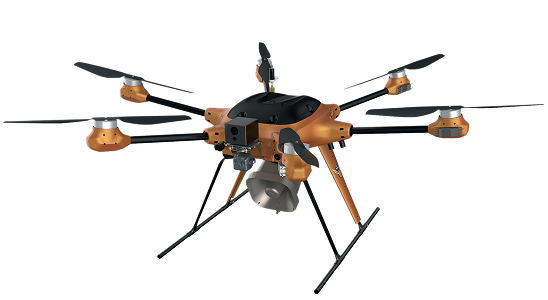



From 2017 to 2020, the Korea Aerospace Research Institute successfully developed a disaster and security response UAV system—comprising UAVs, ground control equipment, communications and operation management systems, and specialized mission payloads—to support rapid information acquisition and effective operations during emergencies and disasters. KARI served as the lead organization for a multi-ministry joint project titled "Development and Operation of an Integrated UAV System for Public Safety Monitoring and Response," which was led by the National Fire Agency with participation from the Ministry of Science and ICT, Ministry of Trade, Industry, and Energy, the Korea Coast Guard, and the National Police Agency.
As Korea’s first private-sector-led project to develop small UAV systems for disaster and public safety applications, the initiative marked a key milestone in the convergence of aerospace and disaster response technologies. A total of 29 organizations, including KARI, participated in technology development, with oversight by the Korea Institute for Advancement of Technology (KIAT). Systems engineering methodologies were applied throughout—from initial mission definition and design phases to prototype fabrication and integrated testing—with expert involvement from the government, academia, and industry.
The disaster response UAV system features mission data multi-point transmission, simultaneous multi-UAV operation and management, waterproofing and dustproofing, wind and heat resistance, triple-mode communication (LTE/WiFi/C-band), and plug-and-play support for 14 types of specialized mission equipment. It also includes a SLAM-based navigation and safety system for seamless UAV operation in GPS-denied or low-visibility environments (e.g., tunnels) and capabilities for beyond visual line of sight (BVLOS) communication and relays. These enhancements were designed to provide differentiated performance beyond conventional UAVs and to support mission success in complex disaster and public safety scenarios involving fire, Coast Guard, and police agencies.
The integrated disaster response UAV system is designed to strengthen preventive safety functions and enhance the rapid initial response capabilities of relevant agencies. It can be deployed in a wide range of scenarios, including earthquake-induced tunnel collapses, fires, toxic gas leaks, radiation leaks, maritime patrol (for search and illegal vessel monitoring), marine pollution incidents, ship, and survivor search and rescue, surveillance of high-crime areas, traffic monitoring, anti-drone operations, and the identification of suspect vehicles or individuals.
In addition,
from 2021 to 2025, the Korea Aerospace Research Institute is developing an anti-drone system named Drone-Cop, designed to neutralize unauthorized drones in flight—an increasingly prominent societal issue.
With advancements in drone performance, intelligence, and swarming capabilities, illegal drone activity has evolved from simple privacy invasions to serious threats, such as attacks on public infrastructure. In response, KARI is developing the airborne response system Drone-Cop along with intelligent neutralization payloads to enable the rapid interception and disabling of unauthorized drones near critical national infrastructure, such as nuclear power plants and airports.
Drone-Cop is an airborne anti-drone response system developed to effectively counter illegal drone intrusions and security threats at major national facilities, such as airports. The system is designed to detect → identify → analyze → neutralize unauthorized drones.
Two types of Drone-Cop UAVs are under development: patrol-type, which monitors areas beyond the coverage of ground-based detection systems, and response-type, which actively engages upon detection. Both are equipped with optical sensors, RF scanners, and onboard radar to track and disable unauthorized drones.
The Drone-Cop system is being developed through a consortium of 12 organizations, including KARI and those from academia, research institutes, and industry. This initiative is laying the technical foundation to capture a significant share of the global anti-drone market, which is projected to reach USD 15.3 billion by 2026.
The system is expected to be integrated with ground-based anti-drone solutions and tested at major critical infrastructure sites, such as airports and nuclear facilities. This will establish a three-dimensional and intelligent anti-drone system for national security applications.
- Dimensions: 580×585×459 mm / Maximum Takeoff Weight: 7 kg / Flight Time: Over 20 minutes / Operating Temperature: -20 to 50℃ / Dust & Water Resistance: IP43 / Heat Resistance: 125℃ (10 seconds exposure)
MC-2 (Outdoor Disaster Response)- Dimensions: 927×930×750 mm / Maximum Takeoff Weight: 17 kg / Flight Time: Over 20 minutes / Wind Resistance: 10 m/s / Operating Temperature: -20 to 50℃ / Dust & Water Resistance: IP43 / Heat Resistance: 125℃ (10 seconds exposure) / Corrosion Resistance: 5% / Salt Spray Test: 48 hours exposure
MC-3 (Outdoor Disaster Response)- Dimensions: 1480×1868×831 mm / Maximum Takeoff Weight: 35 kg / Flight Time: Over 20 minutes / Wind Resistance: 15 m/s / Operating Temperature: -20 to 50℃ / Dust & Water Resistance: IP43 / Corrosion Resistance: 5% / Salt Spray Test: 48 hours exposure